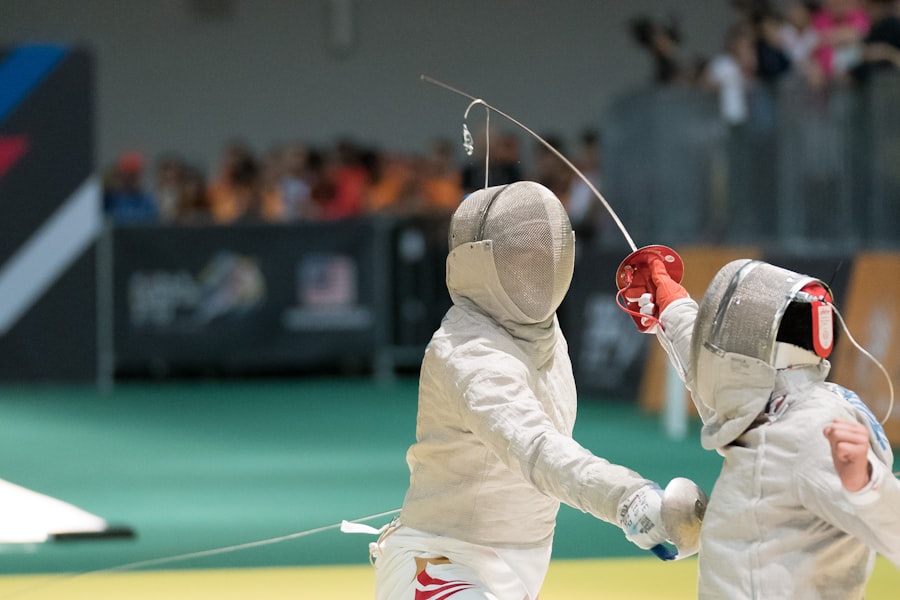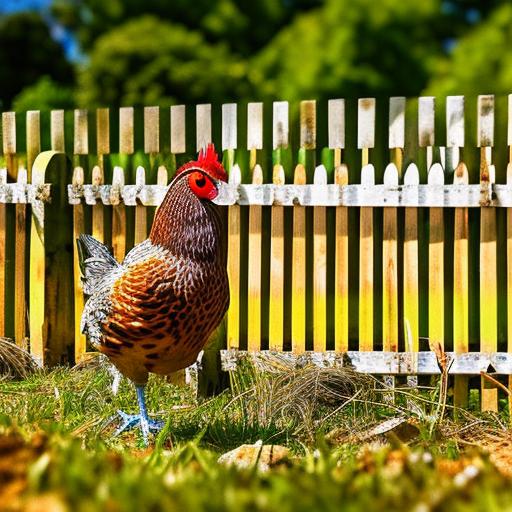Keeping chickens is a fun and rewarding experience, but it requires proper care and attention. One of the most important aspects of raising chickens is providing them with a safe and secure environment. A good chicken fence and coop are essential for protecting your flock from predators and ensuring their well-being. In this blog post, we’ll discuss the importance of a good chicken fence and coop, the different types available, and how to choose the best one for your flock.
Key Takeaways
- A good chicken fence and coop are essential for keeping your chickens safe and healthy.
- There are different types of chicken fences to choose from, including electric fences.
- When choosing a chicken fence, consider factors such as the size of your flock and the predators in your area.
- Electric fences offer benefits such as deterring predators and being easy to install and maintain.
- Building a chicken coop involves choosing the right type, considering factors such as size and ventilation, and properly maintaining it to keep your chickens healthy.
Types of Chicken Fences
When it comes to chicken fences, there are several options to choose from. The most common type of fence used for chickens is chicken wire. It is affordable and easy to find, but it may not be the most secure option. Predators such as raccoons and foxes can easily chew through or dig under chicken wire.
Another option is hardware cloth, which is a stronger and more durable option than chicken wire. It is made of galvanized steel and has smaller openings, making it more difficult for predators to get through. Hardware cloth is more expensive than chicken wire, but it provides better protection for your flock.
Electric fences are also a highly effective option for keeping predators out. They work by delivering a mild electric shock to any animal that comes into contact with the fence. Electric fences are easy to install and maintain, and they provide a strong deterrent against predators. However, they do require an electrical power source, so they may not be suitable for all situations.
Factors to Consider When Choosing a Chicken Fence
When choosing a chicken fence, there are several factors to consider. First, you need to consider the size of your flock. If you have a large number of chickens, you will need a larger fence to accommodate them all.
You also need to consider the type of predators in your area. Different predators have different methods of attack, so you need to choose a fence that will effectively keep them out. For example, if you have problems with digging predators such as raccoons or foxes, you may need to bury the fence underground to prevent them from digging under it.
Your budget is another important factor to consider. Chicken wire is the most affordable option, but it may not provide the best protection. Hardware cloth and electric fences are more expensive, but they offer better security for your flock.
Finally, you need to consider the terrain and landscape of your property. If you have uneven or rocky terrain, you may need to choose a fence that can be easily adjusted to fit the contours of your land.
The Benefits of Using an Electric Fence for Chickens
One of the most effective options for keeping predators out is an electric fence. Electric fences provide a strong deterrent against predators and are easy to install and maintain.
Electric fences work by delivering a mild electric shock to any animal that comes into contact with the fence. This shock is not harmful, but it is enough to deter predators from trying to get through the fence. The shock is delivered through a series of wires that are connected to an energizer, which provides the electrical power.
Electric fences can be moved around to different areas of your property, making them a versatile option for protecting your flock. They can also be easily adjusted to fit the size and shape of your property.
How to Build a Chicken Coop
In addition to a good chicken fence, you also need a secure chicken coop for your flock. A chicken coop provides shelter and protection for your chickens, as well as a place for them to lay their eggs and roost at night.
Building a chicken coop can be a fun and rewarding project. Here are the basic steps involved in building a chicken coop:
1. Determine the size and location of your coop: The size of your coop will depend on the number of chickens you have. Each chicken needs about 4 square feet of space inside the coop. The location of your coop should be well-drained and protected from strong winds.
2. Choose the materials you want to use: There are many different materials you can use to build a chicken coop, including wood, metal, and plastic. Wood is a popular choice because it is durable and provides good insulation.
3. Build the frame and walls: Start by building the frame of your coop using sturdy lumber. Then, attach the walls to the frame using screws or nails. Make sure the walls are secure and provide good ventilation for your chickens.
4. Install the roof and doors: Once the walls are in place, install the roof using roofing materials such as shingles or metal sheets. Make sure the roof is waterproof and provides good protection from the elements. Install doors on the front and back of the coop for easy access.
5. Add nesting boxes and perches: Inside the coop, add nesting boxes for your chickens to lay their eggs. You will need one nesting box for every 3-4 hens. Install perches for your chickens to roost on at night.
The Different Types of Chicken Coops

There are several different types of chicken coops to choose from, depending on your needs and preferences. Here are some of the most common types:
1. A-frame coop: This type of coop is shaped like an A-frame, with a sloping roof that provides good drainage. It is a simple and affordable option for small flocks.
2. Tractor coop: A tractor coop is a portable coop that can be moved around your property. It usually has wheels or skids that allow you to easily move it to different areas.
3. Stationary coop: A stationary coop is a permanent structure that is built on a solid foundation. It provides more stability and security than portable coops.
4. Walk-in coop: A walk-in coop is a larger coop that allows you to walk inside and easily access your chickens. It provides more space for your flock and makes cleaning and maintenance easier.
Tips for Choosing the Right Chicken Coop
When choosing a chicken coop, there are several factors to consider. First, you need to consider the size of your flock. Make sure the coop is large enough to accommodate all of your chickens comfortably.
You also need to choose a coop that is easy to clean and maintain. Look for coops with removable floors or trays that make cleaning out droppings and bedding easier. Make sure the coop has good ventilation to prevent the buildup of moisture and ammonia.
Ensure there is enough space for your chickens to move around and roost. Chickens need about 4 square feet of space inside the coop, as well as outdoor space for scratching and foraging.
Chicken Coop Maintenance and Cleaning
Regular maintenance and cleaning of your chicken coop are essential for the health and well-being of your flock. Here are some tips for keeping your coop clean:
1. Regularly clean out the coop to prevent the buildup of bacteria and pests. Remove all bedding material, droppings, and any leftover food.
2. Replace bedding and nesting material as needed. Bedding material such as straw or wood shavings should be replaced regularly to keep the coop clean and dry.
3. Check for any damage or wear and tear on the coop. Repair any holes or cracks in the walls or roof to prevent predators from getting in.
The Importance of Properly Securing Your Chicken Fence and Coop
Properly securing your chicken fence and coop is essential for protecting your flock from predators. Predators such as raccoons, foxes, and coyotes can easily break into a poorly secured fence or coop.
Make sure all doors and windows are securely closed and locked. Use sturdy locks or latches that cannot be easily opened by predators. Regularly check for any holes or gaps in the fence or coop and repair them immediately.
Finding the Best Fence and Coop for Your Chickens
Choosing the right fence and coop for your chickens is essential for their safety and well-being. Consider the size of your flock, the type of predators in your area, and your budget when making your decision.
With the right fence and coop, you can enjoy the benefits of raising chickens for years to come. Your flock will be safe and secure, and you will have peace of mind knowing that they are well-protected. So take the time to invest in a good chicken fence and coop, and enjoy the rewards of raising chickens in your backyard.
If you’re looking for the best fence to keep chickens in, you may also be interested in learning about the importance of a properly heated chicken coop. Poultry Wizard has a helpful article on choosing the right heater for a chicken coop, which can ensure your feathered friends stay warm and comfortable during colder months. To read more about this topic, check out their article here. Additionally, if you’re wondering where to place your chicken coop for optimal conditions, Poultry Wizard offers valuable insights in their article here. Lastly, if you’re unsure about the size requirements for a chicken coop, Poultry Wizard provides guidance on how big a coop needs to be for chickens in their article here.
FAQs
What is the best type of fence to keep chickens in?
The best type of fence to keep chickens in is a sturdy and secure fence that is at least 6 feet tall. Chicken wire is not recommended as it is not strong enough to keep predators out.
What materials should be used to build a chicken fence?
Materials that can be used to build a chicken fence include wood, metal, and PVC. The fence should be sturdy and secure to prevent predators from getting in.
How high should a chicken fence be?
A chicken fence should be at least 6 feet tall to prevent predators from jumping over it. If there are flying predators in the area, the fence may need to be higher.
What are some common predators that can harm chickens?
Common predators that can harm chickens include foxes, raccoons, coyotes, dogs, and birds of prey such as hawks and owls.
Should the fence be buried underground?
It is recommended to bury the fence at least 6 inches underground to prevent predators from digging under it. The fence should also be secured to the ground to prevent it from being pushed over.
Can electric fencing be used to keep chickens in?
Electric fencing can be used to keep chickens in, but it should be used in addition to a physical fence. The electric fence should be set up at least 6 inches away from the physical fence to prevent predators from reaching through it.
Meet Walter, the feathered-friend fanatic of Florida! Nestled in the sunshine state, Walter struts through life with his feathered companions, clucking his way to happiness. With a coop that’s fancier than a five-star hotel, he’s the Don Juan of the chicken world. When he’s not teaching his hens to do the cha-cha, you’ll find him in a heated debate with his prized rooster, Sir Clucks-a-Lot. Walter’s poultry passion is no yolk; he’s the sunny-side-up guy you never knew you needed in your flock of friends!







